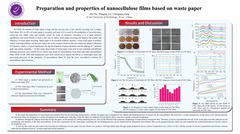Preparation and properties of nanocellulose films based on waste paper
ID:121
Submission ID:53 View Protection:PRIVATE
Updated Time:2021-11-19 13:56:35
Hits:1130
Poster Presentation
Abstract
In China, the amount of waste paper is large and the recovery rate is low, and the recycling way is single. Only about 50% to 65% of waste paper is recycled, and most of it is used for the production of recycled paper, which has low added value and virtually causes the waste of resources. Therefore, it is of great practical significance and social benefit to seek a new way to realize waste paper recycling and improve the quality and efficiency of waste paper recycling. Waste paper is an excellent cellulose resource. Using waste paper to produce widely used nanocellulose can not only reduce the waste of paper resources, but also realize the rational utilization of resources, which is of great significance for the development of green chemistry and the strategy of "emission peak and carbon neutrality".
In this study, three kinds of waste paper were used as raw materials, and different deinking processes were carried out to extract nine kinds of cellulose from them. After acidic hydrolysis, nanocellulose was prepared, and nanocellulose films were obtained by ultrasonic and extraction filtration. SEM, FT-IR, XRD, transparency and other tests were carried out, and the following conclusions were drawn: All nanocellulose films show a certain transparency at macro level, regardless of the type of paper and whether deinking; Microscopically, the composite morphology is regular, that is, the nanoscale fibers are oriented in the middle part of the film and randomly arranged along the edge. In addition, through comparative analysis, the ink-containing waste paper without the deinking process, the composite morphology of nanocellulose transparent film can also be obtained. Therefore, it can be concluded that the ink on waste paper has little influence on the morphology and structure of the nanocellulose. Therefore, the waste paper based nanocellulose prepared in this study can omit the deinking process, which not only simplifies the process flow, but also reduces the production cost.
To sum up, this study not only realizes the recycling of waste paper, but also obtains new products with high added value through simple preparation process and low preparation cost, which creates economic and environmental benefits, and conforms to the concept of resource regeneration and circular economy under the development trend of "emission peak and carbon neutrality".
Keywords
waste paper; Deinking; Nanocellulose; Thin film
Submission Author
Hui Pei
Xi'an University of Technology
Wanqing Lei
Xi’an University of Technology
Chanqing Fang
Xi’an University of Technology



Comment submit